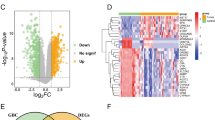Abstract
Purpose
An increasing number of studies have shown that PUMA and C-myb signaling pathways are involved in various human cancers including colon carcinomas. However, few studies have examined gallbladder cancer specimens, and little is known about the clinical and pathological significance signaling changes may have in gallbladder adenocarcinoma. This study has investigated the expression of PUMA and C-myb in benign and malignant lesions of gallbladder and its pathological significance.
Methods
Tissue specimens from 108 gallbladder adenocarcinoma patients, 46 adjacent tissues, 15 cases of adenomatous polyps, and 35 surgical specimens from chronic cholecystitis patients were routinely paraffin embedded and sectioned. PUMA and C-myb expressions were detected with EnVision immunohistochemistry.
Results
Positive rates of PUMA and C-myb are significantly higher in gallbladder adenocarcinoma tissues than that in the other three (P < 0.01). Gallbladder epithelial cells in PUMA and/or C-myb positive benign cases manifest moderate to severe atypical dysplasia. Positive rates of PUMA and C-myb in well-differentiated tumors with maximum diameter of <2 cm and with no lymph node metastasis and invasion of the surrounding tissues are significantly lower than that in those poorly differentiated cases with maximum diameter of ≥2 cm, lymph node metastasis, and invasion of the surrounding tissues (P < 0.05 or P < 0.01). The postoperative survival of patients whose tumor specimens are positive for PUMA and C-myb is significantly shorter than that of those who are negative for both markers (P < 0.05 or P < 0.01).
Conclusions
Our results have demonstrated that PUMA and C-myb positive gallbladder tumors progress rapidly, are prone to metastasis, possess strong invasive ability, and have poor prognosis.


Similar content being viewed by others
References
Yu J (2009) PUMA kills stem cells to stall cancer. Mol Cell Pharmacol 1(3):112–118
Letai A (2009) Puma strikes Bax. J Cell Biol 185(2):189–191
Yee KS, Wikinson S, James J, Ryan KM, Vousden KH (2009) PUMA and Bax-induced autophagy contributes to apoptosis. Cell Death Differ 16(8):1135–1145
Sinicrope FA, Rego RL, Okumura K, Foster NR, O’Connell MJ, Sargent DJ et al (2008) Prognostic impact of bin, puma, and noxa expression in human colon carcinomas. Clin Cancer Res 14(18):5810–5818
Diallo JS, Aldejmah A, Mouhim AF, Péant B, Fahmy MA, Koumakpayi IH et al (2007) NoXA and PUMA expression add to clinical markers in predicting biochemical recurrence of prostate cancer patients in a survival tree model. Clin Cancer Res 13(23):7044–7052
Ransay RG, Gonda TJ (2008) MYB function in normal and cancer cells. Nat Rev Cancer 8(7):523–534
Oh IH, Reddy EP (1999) The myb gene family in cell growth, differentiation and apoptosis. Oncogene 18(19):3017–3033
Gonda TJ, Leo P, Ramsay RG (2008) Estrogen and MYB in breast cancer: Potential for new therapies. Expert Opin Biol Ther 8(6):713–717
Wilkins HR, Doucet K, Duke V, Morra A, Johnson N (2010) Estrogen prevents sustained COLO-205 human colon cancer cell growth by inducing apoptosis, decreasing C-myb protein, and decreasing transcription of the anti-apoptosis protein bcl-2. Tumor Biol 31(1):16–22
Yang H, Huang ZZ, Wang J, Lu SC (2001) The role of C-myb and SP1 in the up-regulation of methionine adenosyltransferase 2A gene expression in human hepatocellular carcinoma. FASEB J 15(9):1507–1516
Brabender J, Lord RV, Danenberg KD, Metzger R, Schneider PM, Park JM et al (2001) Increased C-mybmRNA expression in Barrettses ophagusand Barretts-associated adenocarcinoma. J Surg Res 99(2):301–306
Nürnberg W, Artuc M, Nawrath M, Lovric J, Stüting S, Moelling K et al (1995) Human C-myb is expressed in cervical carcinomas and transactivates the HPV-16 promoter. Cancer Res 55(19):4432–4437
Kim SY, Yang YS, Hong KH, Jang KY, Chung MJ, Lee DY et al (2008) Adenovirus-mediated expression of dominant negative c-myb induces apoptosis in head and neck cancer cells and inhibits tumor growth in animal model. Oral Oncol 44(4):383–392
Hoque MO, Begum S, Sommer M, Lee T, Trink B, Ratovitski E et al (2003) Puma in head and neck cancer. Cancer Lett 199(1):75–81
Jansson A, Arbman G, San XF (2004) mRNA and protein expression of PUMA in sporadic colorectal cancer. Oncol Rep 12(6):1245–1249
Acknowledgments
We wish to acknowledge the following people for their contribution of cases to this study: Zhulin Yang, Xiongying Miao, Yu Wen, Shengfu Huang, Junyi Ouyang.
Conflict of interest
None.
Author information
Authors and Affiliations
Corresponding author
Rights and permissions
About this article
Cite this article
Cai, W., Li, Q., Yang, Z. et al. Expression of p53 upregulated modulator of apoptosis (PUMA) and C-myb in gallbladder adenocarcinoma and their pathological significance. Clin Transl Oncol 15, 818–824 (2013). https://doi.org/10.1007/s12094-013-1010-8
Received:
Accepted:
Published:
Issue Date:
DOI: https://doi.org/10.1007/s12094-013-1010-8




